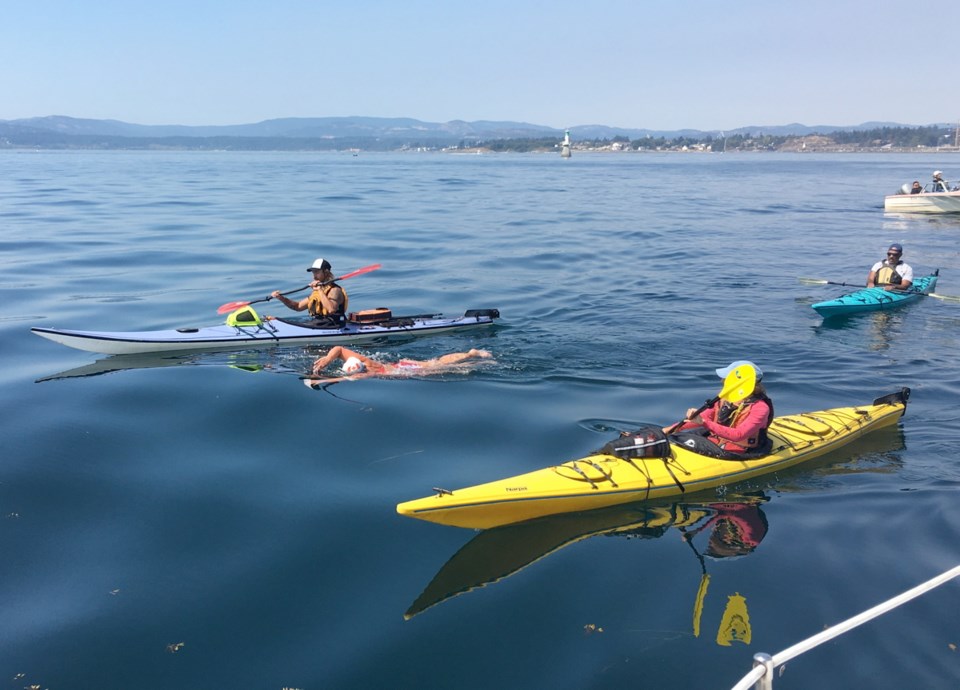Last weekend, I boarded a sailboat and joined Susan Simmons’ support crew for her attempt at the double crossing of Juan de Fuca Strait. I was tasked with updating her social media throughout the swim.
“If I am struggling, I want you to tell people that,” Simmons explained to me. She also said very matter-of-factly: “You also need to know that I may not finish the double crossing.”
This is one of the reasons I truly admire Simmons. She doesn’t hide the hard stuff. All too often, we see people do amazing things and never hear much about the struggle to get there. It’s the struggle that makes it relatable to others. Most things don’t come easy to anyone.
Simmons was diagnosed with multiple sclerosis about 12 years ago, and she explained at that point in her life she struggled to walk a block and was a shut-in confined to her home. She eventually decided to try to regain her health amid the diagnoses. She started working on her diet and decided to resume swimming, which had been a childhood passion.
Simmons has made a name for herself in open-water swimming, she has completed various open-water swims in our region and beyond. Last year, she swam Juan de Fuca Strait in 10 hours and six minutes.
On Aug. 18, about 50 people came to Ogden Point to wish Simmons well on her attempt at the double crossing of the strait. One of those people was a close friend struggling with a looming lupus diagnosis. Simmons explained lupus and MS are both autoimmune diseases.
As they hugged before Simmons embarked on her swim, her friend started crying, and Simmons told me what a struggle this has been for her friend.
“When you are first diagnosed, it takes a huge toll on you until you can find your health,” Simmons said. “This is why I am swimming. I had it in my head that I am swimming for her.”
The swim started off with calm waters, but the water soon became choppy and several people on the sailboat were seasick. I watched Susan swim through four-foot waves. When she stopped for a drink or snack, the waves washed over her head as she treaded water.
Simmons swam for 8.5 hours in 9C waters. Last year, the water temperatures for her swim spanned between 11 and 13C. A swimming pool is between 25 and 28C.
This attempt was the longest Simmons has ever swum in water that cold. The smoky skies could have played a role in this, with the sun not being able to heat the water the way it could with a clear sky. The kayakers on the trip noticed a lot of ash floating on the water.
It takes courage to announce a bold goal. It takes more courage to tell all your friends and get a crew of 13 people to come out and support you. Simmons broadcast her goal on various news outlets, including the Times Colonist.
When the swim stopped, it all happened very quickly. A support kayaker radioed the support boat and said Simmons might have to stop the swim. About three minutes later, she was being towed by a kayak to the boat.
“I crashed all at once,” Simmons said after the swim. “Before the swim, I told myself if I started shivering, I would remove myself. I do these swims to promote health and fitness. If I had done something to harm my body, I wouldn’t be promoting that.”
Simmons climbed on the boat and looked at everyone and said she was sorry. We all clapped for her and let her know how proud we were. She was hypothermic and shaking, then she vomited and went down to the cabin with her partner, Ray Este.
“I comforted her and gave her a big bear hug,” said Este. “Her teeth were really chattering. I’ve seen it many times, but it still makes me nervous. She’s definitely a tough one.”
Simmons might not have completed the double crossings, but she did raise awareness for Multiple Sclerosis and health and wellness.
In no way did Simmons fail. After watching her persevere in the conditions she did, I learned you have to fight for what you want, and if it gets unsafe, it’s OK to stop.
Charla Huber works in communications and Indigenous relations for M’akola Group of Societies.



